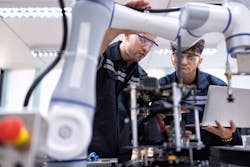Quality checks in camera systems ensure accurate and reliable image output, leading to improved performance. Programmable-logic-controller (PLC) programming automates quality checks in camera systems by enabling the implementation of logical algorithms, ensuring consistent and efficient inspection processes for enhanced product quality and reliability.
Camera systems are used for quality checks in various industries. They capture images or videos of products or processes, allowing for visual inspection and analysis. Quality check requirements include image resolution, accuracy, speed, lighting conditions and automated analysis capabilities. Common communication protocols used in PLC-camera integration include Ethernet/IP, Modbus TCP/IP and Profinet. These protocols enable seamless data exchange between the PLC and the camera, allowing for real-time control, monitoring and data acquisition in industrial automation applications.
When considering seamless integration of camera systems, hardware considerations include compatible interfaces and connectors, sufficient processing power and adequate storage capacity. Software considerations involve compatibility with existing systems, programming languages and application programming interfaces (APIs) for data exchange and control functionalities.
Critical quality parameters for camera systems include resolution, image sensor type, sensitivity, dynamic range, frame rate, color accuracy, low-light performance, lens quality and image-stabilization capabilities. The logical steps for quality check procedures typically include inspecting physical components, performing functional tests, evaluating performance metrics, conducting user-experience testing and verifying compliance with specifications and standards. To implement algorithms using ladder-logic programming, define inputs and outputs, create rungs with logical operations, use timers and counters for sequencing and test the program for desired functionality and performance.
It is essential to test quality control systems in order to guarantee accurate and trustworthy findings. It increases the program's efficacy, helps find and fix any mistakes or inconsistencies and guarantees that it satisfies all necessary requirements for quality standards and specifications. You may utilize software-based simulation tools that imitate camera inputs to test program outputs and simulate camera inputs.
Verifying the program's outputs versus the anticipated outcomes can also be facilitated by manually entering test data or by utilizing, for example, photos or videos. Examine the code carefully, look for syntax mistakes, debug with print statements or a debugger and look at error messages.
Successful PLC programming for camera quality checks involves a combination of techniques. First, image comparison algorithms are implemented to detect defects like color variations or missing components. Second, pattern recognition techniques are used to identify specific patterns or shapes in the image. Additionally, barcode or QR-code readers are integrated to verify product information. This ensures the accurate identification and tracking of products.
By combining these techniques, PLC programming enables efficient and reliable quality checks for camera-based inspections. Automation brings numerous benefits and improvements, including increased productivity, reduced errors, improved efficiency, cost savings, faster processing times, streamlined workflows and the ability to handle repetitive tasks with precision and consistency.
Real-world implementations of automation have taught us the importance of thorough planning, effective communication, regular testing and monitoring, flexibility to adapt to changes and providing proper training and support to employees.
Advancements in PLC technology have revolutionized camera systems by enabling seamless integration, enhanced control, real-time data processing, improved accuracy and increased reliability, resulting in more efficient and effective surveillance and monitoring. Artificial-intelligence (AI) and machine-learning (ML) integration in quality checks holds immense potential for streamlining processes, improving accuracy, detecting anomalies, predicting defects, optimizing production and ultimately ensuring higher product quality and customer satisfaction. In the future, PLC programming in camera systems will continue to evolve, with advancements in automation, real-time analytics, machine vision and connectivity leading to smarter and more versatile surveillance solutions with enhanced functionalities and efficiency.
PLC programming plays a crucial role in camera quality checks by ensuring accurate and reliable inspection processes. It enables the automation of tasks such as image analysis and defect detection, improving efficiency and reducing human error. With PLC programming, camera systems can perform real-time quality checks, identify flaws in products or processes and enable proactive measures to maintain high standards and customer satisfaction.
About the Author
Shawn Cox
Contributing Editor
Shawn Cox is a licensed master electrician/PLC programmer. He was co-owner/operator of Bobby Cox Electric for 15 years and is currently employed by BMW Manufacturing as an ESA. Contact him at [email protected].

Leaders relevant to this article:

